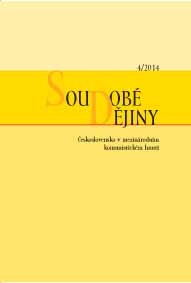Němci v poválečném Československu: Jedinečná edice dokumentů z českých archivů boří tradované legendy
The Germans in Post-war Czechoslovakia: A Unique Edition of Documents from Czech Archives Buries Traditional Legends
Author(s): Eva HahnováSubject(s): History
Published by: AV ČR - Akademie věd České republiky - Ústav pro soudobé dějiny
Summary/Abstract: This is a review of the three volumes published so far in a large project called The Expulsion of the Germans and Changes in the Czech Borderlands, 1945–51, the work mainly of the Swiss historian Adrian von Arburg and his Czech colleague Tomáš Staněk. The reviewer discusses their research and the resulting publications in the context of the wider discourse on mass migrations (including the transfers and expulsions) of peoples of Europe after the Second World War. She criticizes the concept of ethnic cleansing as it has been interpreted and explained to the general readership particularly by the American historian Norman M. Naimark (b. 1944, Professor of Eastern European Studies at Stanford). This concept, she argues, ignores the empirical research on the special aspects of the historic situations, particularly the political factors of various forms of migration, and it instead constructs, on the basis of superficial similarities between the migrations, a generalizing picture of the overall misguideness of Europeans in the twentieth century. Through this lens, some authors have then also used the misleading comparison of the repressive practices of the Nazi regime and the post-war Czechoslovak regime, as personified by Adolf Hitler and the Czechoslovak President Edvard Beneš. From what she has discovered in her own research, the reviewer argues that these scholarly approaches often merely revive, or keep alive, legends and stereotypes that have been passed on in German interpretations of the expulsion of the Czechoslovak Germans and the events leading up to them. She illustrates this with examples from the propagandistic post-war writings of the head of the Sudeten German Social Democrats, Wenzel Jaksch (1896–1966), and his adherents, which were formulated for the international public. The reviewer also provides an overview of published editions of historical sources on the expulsion of the Czechoslovak Germans, and she emphasizes the newness of Staněk and von Arburg’s approach. Though they consider the same historical events, the works by these two scholars do not, unlike other editions, use emotionally coloured rhetoric, nor do they pursue political ends; rather than judge, they explain, and thanks to that, offer evidence on the arduous experiences of the Czechoslovak Germans which is more persuasive than propagandistic interpretations. In addition to systematically making hitherto forgotten documents from dozens of Czech archives and eyewitness statements accessible for the first time, Staněk and von Arburg critically compare them with other available information. One more essential difference between the publications in this series and other works on the topic is that that they look at migration in post-war Czechoslovakia geographically unlike the hitherto usually historical but outmoded ethnic view.
Journal: Soudobé Dějiny
- Issue Year: XXI/2014
- Issue No: 04
- Page Range: 635-653
- Page Count: 19
- Language: Czech

